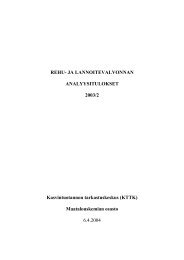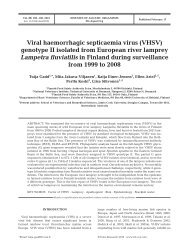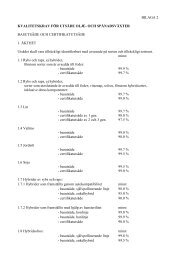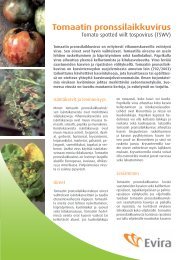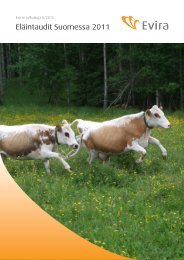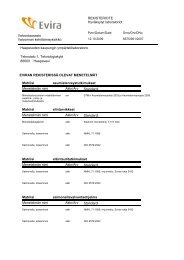Genetic characteristics of field and attenuated rabies viruses ... - Evira
Genetic characteristics of field and attenuated rabies viruses ... - Evira
Genetic characteristics of field and attenuated rabies viruses ... - Evira
Create successful ePaper yourself
Turn your PDF publications into a flip-book with our unique Google optimized e-Paper software.
1. Literature review<br />
1.1. Definition <strong>and</strong> history <strong>of</strong> <strong>rabies</strong><br />
Rabies is a fatal viral zoonosis which causes encephalitis in many warm-blooded<br />
animals <strong>and</strong> humans. There have been indications relative to the occurrence <strong>of</strong> <strong>rabies</strong><br />
since the time <strong>of</strong> Homer (eighth century B.C.) onwards. The first archival appearance <strong>of</strong><br />
the disease was in the fourth century B.C., but precise diagnosis was not possible before<br />
the first century B.C. (Blancou, 1994, 2004; Neville, 2004). The first human <strong>rabies</strong><br />
vaccine was developed in 1885 by Louis Pasteur <strong>and</strong> since then, significant<br />
developments have been made in this <strong>field</strong> including progress in laboratory diagnosis,<br />
vaccination <strong>and</strong> <strong>rabies</strong> control in wild, domestic <strong>and</strong> farm animals (King et al., 2004).<br />
1.2. Rabies virus <strong>characteristics</strong><br />
1.2.1. Classification<br />
The <strong>rabies</strong> virus belongs to the order Mononegavirales, family Rhabdoviridae,<br />
which includes at least three genera: Lyssavirus, Ephemerovirus, <strong>and</strong> Vesiculovirus<br />
(Virus Taxonomy, 2005). The Lyssavirus genus is further divided into seven genotypes.<br />
The genotype 1 is known to be the most widespread <strong>and</strong> comprises the classical <strong>field</strong><br />
<strong>rabies</strong> <strong>viruses</strong>, <strong>and</strong> the laboratory <strong>and</strong> vaccine strains. The <strong>rabies</strong>-related <strong>viruses</strong> isolated<br />
in the African continent belong to genotypes 2, 3, <strong>and</strong> 4, with prototypes <strong>of</strong> the Lagos bat<br />
virus, Mokola virus, <strong>and</strong> Duvenhage virus, respectively. The <strong>viruses</strong> isolated from bats in<br />
Europe represent genotypes 5 <strong>and</strong> 6 (EBLV1 <strong>and</strong> EBLV2). The Australian bat Lyssavirus<br />
(ABLV) represents the seventh genotype (Gould et al., 1998; Guyatt et al., 2003).<br />
It has been found that some new <strong>rabies</strong> virus genotypes exist among <strong>viruses</strong><br />
isolated from the territory <strong>of</strong> the former Soviet Union. It was proposed that the Aravan<br />
virus isolated from a bat in Kyrgyzstan should be classified as the eighth genotype (Arai<br />
et al., 1997). The Khuj<strong>and</strong> virus isolated in Tajikistan can also be classified as a separate<br />
genotype <strong>of</strong> Lyssavirus (Kuzmin et al., 2003). The existence <strong>of</strong> two additional Lyssavirus<br />
genotypes among strains isolated from bats (Irkut virus <strong>and</strong> West Caucasian Bat Virus) in<br />
the Russian Federation was also recently proposed (Botvinkin et al., 2003; Kuzmin et al.,<br />
2005).<br />
9



